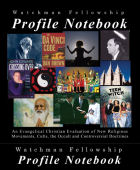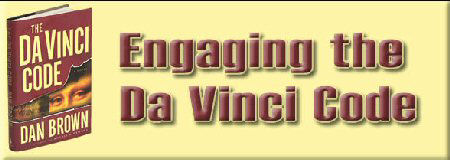
Watchman Fellowship, Inc.
Subscribe to our email list and receive discounts and special offers from Watchman
New--Now Available

The Profile Notebook on CD-ROM $19.95!

Quick Links
New Age
- A Message in that Massage
- Alternative Health Care
- Beam Me Up, Scotty
- Bo and Peep's Lost Sheep
- East of Center
- Engaging the Da Vinci Code
- Evaluating Acupuncture
- Healing With Crystals
- It Ain't Yogi Berra
- Lucas' Gospel, Part I
- Lucas' Gospel, Part II
- Meeting Next Level Recruiters
- More Da Vinci Code
- New Age in Sports
- Next Level Scripture Twisting
- Oprah's Gospel
- Raelian Clone
- Stephen Covey's Paradigms
- The Da Vinci Code
- The Da Vinci “CON”troversy
Members of:
Profile Notebook
 Only $39.95, this 312 page-plus binder includes over 75 Profiles. Also available as CD-ROM or Download!
Only $39.95, this 312 page-plus binder includes over 75 Profiles. Also available as CD-ROM or Download!
For more information on the New Age and Postmodernism movements, please visit our web catalog; or click here to order a free information packet.
To The Source

Dear Concerned Citizen,
Dan Brown’s The Da Vinci Code has hit #1 on every bestseller list in America. It is being translated into more than 35 languages. With more than 4 million copies in print, Brown was able to sell the movie rights this summer to Columbia pictures for $6 million. Ron Howard was signed to direct and Brian Grazer to produce the film.
The Da Vinci Code, a spiritual thriller tucked inside a conspiratorial mega-romance novel (pagans love women, Christians hate them), has captured the imagination of millions which promotes the deconstruction of the church. Toward this end Brown and his P.R. team promote the book’s theories as history, not fiction. The first written word of Chapter 1 is “Fact”.
After the book surged to the top of the charts, Brown was featured on an ABC News Special. There he disclosed his own belief in the theories that the book espoused. These include:
Jesus was a rich opportunist with aims at reclaiming the throne of David. Jesus fell in love with Mary Magdalene because of her wealth and because she carries the royal blood of Benjamin.
“Almost everything our fathers taught us about Christ is false,” laments one of Brown’s characters.
In one of the 50-odd texts of the Gnostic Gospels one line states that Mary Magdalene was Jesus’ favorite and he often kissed her on the mouth, according to Brown. In fact, the parchment is so damaged it is impossible to read what kind of kiss Jesus gave Mary. The texts also identify Mary Magdalene as the companion of Jesus. Brown believes the term means she was Jesus' wife.
Mary Magdalene and the offspring she bears with Jesus are the Holy Grail, not Jesus’ cup at the Last Supper. Michael Baigent promoted this theory in his 1983 book Holy Blood, Holy Grail. The name of the historian in The Da Vinci Code is Teabing, an anagram for Baigent. Brown should tip his hat to Baigent. Brown will make tens of millions off of Baigent’s theory.
Mary Magdalene and her “royal bloodline” end up in Provence, France. The Grail-keepers (Templar Knights, Cathars, and other secret societies) protect her relics, proof of this powerful secret that, if widely known, will destroy the church. This bloodline has been kept pure through the Merovingian dynasty in Dark Ages France until today in several prominent French families represented by the Priory of Sion. Unfortunately for Brown, no evidence substantiates The Priory before World War II. But then, that makes it all the more mysterious.
“The Grail,” Langdon said, “is symbolic of the lost goddess. When Christianity came along, the old pagan religions did not die easily. Legends of chivalric quests for the Holy Grail were in fact stories of forbidden quests to find the lost sacred feminine. Knights who claimed to be “searching for the chalice” were speaking in code as a way to protect themselves from a Church that had subjugated women, banished the Goddess, burned non-believers, and forbidden the pagan reverence for the sacred feminine.” (The Da Vinci Code, pages 238-239)
Constantine and other early church leaders unite the Roman Empire into a woman and pagan hating monolith (Christendom). At the Council of Nicea in AD 325 they invent the divinity of Christ (Constantine couldn’t fully relinquish his Son God paganism) and the universality of the Catholic Church to unite the Roman Empire under one religious militia. Until that time Christians believed Jesus was only human, an assertion dispelled by vast historical evidence, not to mention the martyrdom of thousands of Christians.
To find out how Brown develops this plot, you will have to buy The Da Vinci Code. Don’t worry, complex characters, a believable plot line, and accurate research won’t impede your read. You might find his numerous lectures on why his conspiracy theory is fact somewhat tiresome.
The buzz over The Da Vinci Code has fueled renewed interest in subjects usually reserved to academic journals and theology books. The emphasis in many churches is on experiencing faith through worship. The success of The Da Vinci Code challenges this as incomplete. Believers need to know their faith, not just feel it. Church history was once an essential part of a liberal arts education within the context of teaching Western Civilization. Today schools no longer teach Western Civilization and the church has long abandoned its responsibility to teach its history to its people (believers).
Contrary to a claim made by a character in Brown’s novel, the vast majority of Christians do NOT know the history of their faith. Because of this members of Stanwich Church came out in droves when their pastor, Reverend Neely Towe, sensed this controversial book presented a unique opportunity to teach the basics of church history. She put together a series of four lectures called Christianity and the Da Vinci Code. She drew from existing resources to give a coherent framework for discerning facts from fiction in the novel. The lunchtime lectures were given at a local country club and open to the public. The response was so positive she is repeating them this January and February, as an evening series.
Many critics and academics have written articles to “break”, “crack”, “decipher”, “dismantle” and “dismiss” the code. Philip Jenkins, Professor of History and Religious Studies at Penn State University and the author of a new book The New Anti-Catholicism writes that, “In the end, The Da Vinci Code simply appeals to a culture that's increasingly skeptical of claims to religious truth.”
"I think anti-Catholicism is a contributory factor, but the main reason for the book's popularity is deeper, a fundamental suspicion of traditional claims to authority, where they conflict with contemporary ideas and standards, especially over sex and gender…It mainly illustrates a broader suspicion about orthodoxy generally, and the idea that the truth is out there."
The antidote to the book’s criticism of orthodoxy is certainly not to assert that all was right with Christendom. In all of its Gothic and resplendent glory, Christendom had countless failings as do all cultural epics that encompass a billion lives over a thousand years. But it must be said that much good came from Christendom. Brown suggests otherwise in The Da Vinci Code:
“The Church may no longer employ crusades to slaughter, but their influence is no less persuasive. No less insidious.”
We live in a post-Christendom world. If Brown and others like him have their way, we will be living in an exclusively secular, post-Christian culture. This would be unfortunate, as would be the loss of any great tradition. The antidote to Brown’s criticism of Christianity is sound academic research and teaching, and people like Neely Towe who are willing to teach it.
Brown asserts that “Every faith in the world is based on fabrication.” Fabrication is one word that comes to mind to characterize The Da Vinci Code.
Excerpted from the tothesource E-letter dated December 12, 2003
Da Vinci Code Resources
- Cracking Da Vinci's Code, James L. Garlow and Peter Jones, Chariot Victor; (April 1, 2004).
- The Truth Behind the Da Vinci Code, Richard Abanes, Harvest House Publishers, Inc.; (April 21, 2004).
For more information on the New Age and Postmodernism movements, please visit our web catalog; or click here to order a free information packet.
© 2005 Watchman Fellowship of Alabama (http://www.wfial.org). All rights reserved. Site designed by Brad Blan
Read our privacy policy
 Home
Home Store
Store Print
Print Email
Email
